#humanized steam locomotives
Explore tagged Tumblr posts
Text

Happy new year everyone!
#gecp's engines#drawing#train#steam locomotive#traditional drawing#doodles#my drawing#oc#my art#coloured pencils#pencil sketch#humanized steam locomotives
22 notes
·
View notes
Text
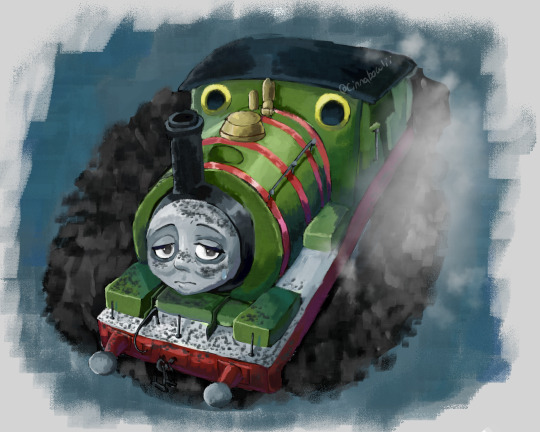
experimental charcoal painting, (does it still count as a painting if its digital?) of a screengrab from the episode "thomas percy and the coal". (✿◠‿◠)
i kinda just did this on impulse, practacing my skills on drawing locomotives, i think i did kinda well (づ。◕‿‿◕。)づ
i think tumblrs gonna kill the quality so heres a close up shot:
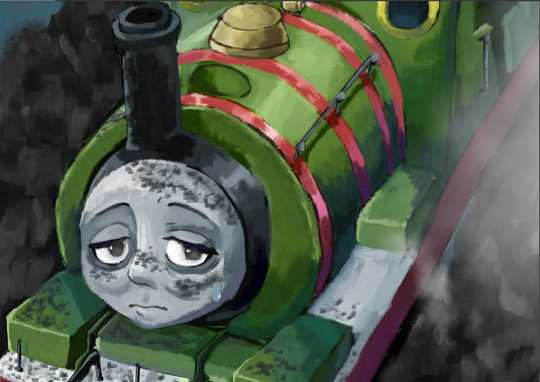
and the og screencap i took inspo from

#thomas and friends#thomas the tank engine#ttte#ttte fanart#ttte humanized#cinnabowliiart#ttte au#ttte humanised#digital art#ttte percy#clip studio art#clip studio paint#clip studio illustration#artists on tumblr#digital artist#artwork#steam locomotive#percy the small engine#percy the green engine#thomas the tank engine and friends
121 notes
·
View notes
Text

Rusty is maybe just a little bit short for this configuration of a celebratory hug...
But anyway they won a race together yayyyyyyy
#starlight express#rusty the steam engine#pearl the observation car#of course my hc is that pearl is taller than rusty what do you take me for#this might make their height difference look RIDICULOUS but it's not#rusty is leaning backwards/lifting pearl slightly and she has her leg extended to push off the ground leaning into him#the top of his head does only come up to her nose though#idk if i'm headcanoning them as being human scale or not#but as humans she'd be 5'9 and he'd be 5'5#(175cm/165cm)#trainsformers locomotive guys
24 notes
·
View notes
Text
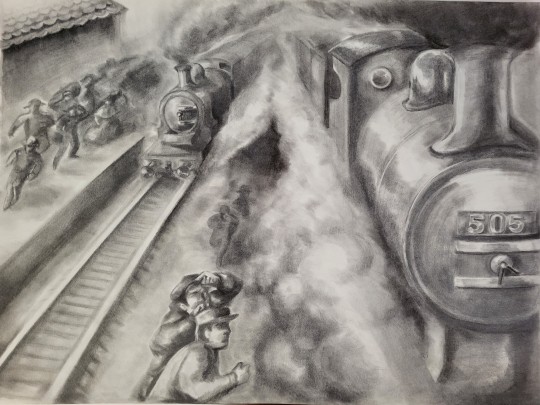
"Runaway on the LMS", 2022, graphite
Close ups:


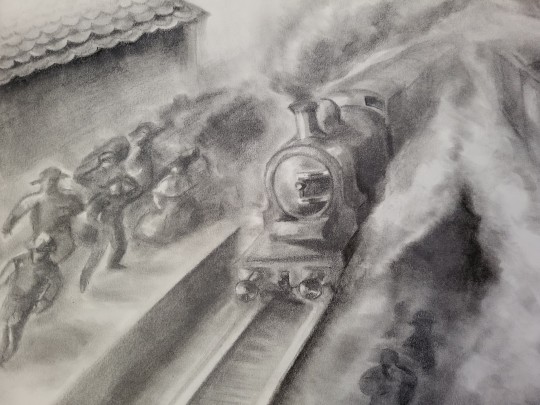
Please do not repost without permission!
#randomly remembered that this existed while i was cleaning my room#and its WAY too good not to post#i worked on it for about 2 weeks maybe 3#and it was for college assignment#the engines have no particular basis but feel free to speculate!!!#humans will always be fucking impossible to shade w graphite istg#real life railway#kips art#art#steam locomotive#london midland and scottish railway#artists on tumblr#traditional art#college artist
235 notes
·
View notes
Text
Humanized Polar Express

My take on a humanized/anthro/sentient Polar Express.
Appearance:
A Baldwin s3 2-8-4 and Pere Marquette 1225 hybrid locomotive man. Wears a puffer jacket w/ traditional Inuit fur-trimming, ice skates, mittens, and three jingle bells on the hood.
Personality:
courageous, intelligent, wise, skeptical (formerly), faithful, practical, aloof, blunt, hardy, generous, sacrificial
Backstory:
The Polar Express initially worked on the Chesapeake and Ohio Railway in North America. His real name is Kuvianak, meaning "joy". He is of Inuit heritage: can speak Aivilimmiutut and knows how to survive in hardy weather. Kuvianak died from crashing on ice during an extreme blizzard. He was not scrapped, but put on display until The Christmas Spirit whisked him away.
Kuvianak is now a magical holiday train who brings children from around the world to The North Pole, where they meet Saint Nicholas. When he was assigned this job, he was hesitant. Christmas is a Christian holiday. But Kuvianak was a Pagan; he didn't want to let go of his traditions.
Converted to Christianity, The Polar Express saw Christmas for what it truly meant. His motto: believe. "Though I've grown old, the bell still rings for me as it does for all who truly believe."

#my writing#writing snippet#character bio#humanized#humanization#the polar express#humanized locomotive#steam locomotive#humanized design#christmas movie#my art#long post
5 notes
·
View notes
Text

belated 100th for Flying Scotsmen holy shit he's that old
#kinda happy with his humanised design but still need to simplyfy it a lil bit#But still yaayy the dude is 100 now hope his brother his happy about that (derogatory)#my shit#ttte#ttte fanart#ttte flying scotsman#ttte humanisation#ttte human au#flying scotsman#steam locomotive
58 notes
·
View notes
Text
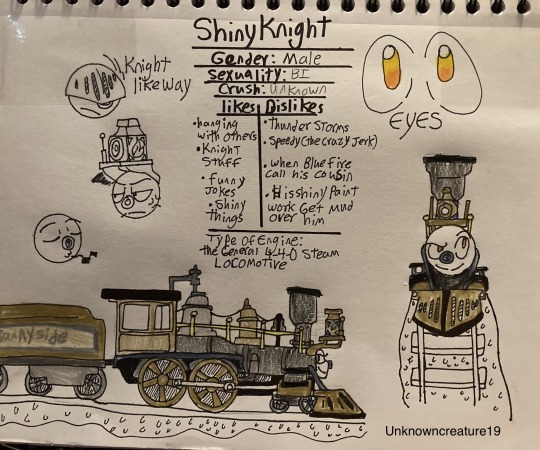
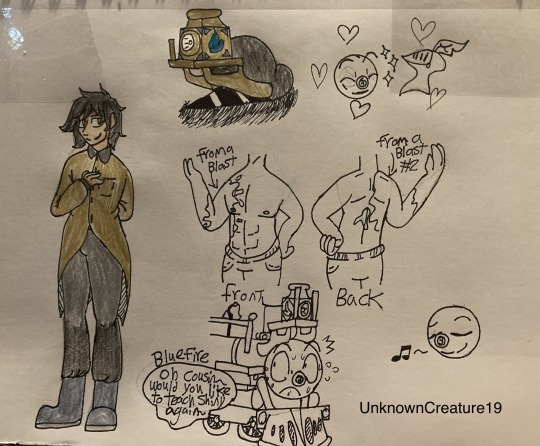
Finally, I got redesign of shiny knight!! and yes, I forgot to put the old ref in this, but I lost it so you can look at my old posts! But yeah, here he is!! he is a The General 4-4-0 Steam Locomotive! And I had fun with him drawing him. Of course he’s the same color and everything but just more like attitude and if you’re wondering that “oh cousin~” thing, it’s from a role-play that me and my great friend @projectanimations did which shiny knight is scared shitless when he met the ghost trio, and every time shiny said, something stupid, or says about spirits, blue fire would say “ oh, cousin~ my wonderful cousin~ Would you like to bring your friends to teach him again?” Shiny would freak out and run off or close his door shut Lol! and yes, he did make it from a blast. It did hurt him, but thankfully he survived, and he still love royal knights stuff. But now he starting to like shiny things too lol!
Base of: 



#Shiny Knight The General 4-4-0 Steam Locomotive#Shiny Knight#train#trainoc#Humanize Shiny Knight#I am not dead! Just been very stressful! But I had fun drawing him!
14 notes
·
View notes
Text
My anatomy said "no" today
Anyways Jumbo.




#thomas the tank engine#thomas and friends#ttte humanized#ttte#ttte oc#steam locomotive#steam engine
18 notes
·
View notes
Text
Good point. They don’t usually start out life as haters n such. This goes for any gender. They are shaped by their environment. Peers , the media they consume, relatives, friends, etc. instill toxic thoughts into them. If they are not taught straight away to think for themselves - question BOTH sides of arguments, do research, and use logical common sense thinking, they will wind up biased. That’s how these things REALLY occur. That is only one example. Sadly, whilst a lot of what modern people ‘advocate’ for isn’t completely wrong or false, they believe and spread misinformation, because it’s more socially gratifying.
It’s the crowd on a bridge mentality-
I used to be annoyed af hearing this growing up. Now that I’m older and wiser, I see the value in it. Sadly, you would THINK the most obvious answer to the question is ‘no’. And verbally, it may be. However, in actions, it’s very different. This is why narcissists gain followers so easily. Some folks are afraid to stand up against the narcissist. Others think that they will benefit from the praise they get by following along. In truth, they’re allowing themselves to be used. It’s a sad existence, really. The narcissists suck the soul out of their followers.
This has a lot of relevance in terms of wokeness as well. Consider the following:
https://criticaltherapyantidote.org/2022/09/25/group-narcissistic-manifestations-in-critical-social-justice-aka-woke-movements-part-1/
The first, overarching feature of the Woke worldview is the common-enemy (a type of paranoid defence) position its adherents and purveyors assume in the world. The Woke common-enemy position is an identitarian position, in which society is politically categorised according to immutable characteristics as identity markers (race, sex/gender, sexual orientation, ability, etc.). By assigning moral value to these characteristics, in-group/out-group social dichotomies are created, and society is split between an oppressed, innocent victim class on the one hand, and a hostile, evil oppressor class on the other. The Woke worldview is a system in which collectives are morally essentialised. Assigned collective innocence or guilt serves as a template to judge each interaction on an individual level, including each participant’s feelings, intentions, judgments, wishes and character traits. ‘The question isn’t did racism (or sexism or homophobia or transphobia or ablism, etc.) take place, but rather, where it took place’ as DiAngelo proclaims. The psychodynamic defence in operation here is splitting, which is a primitive defence mechanism whereby individuals experience themselves or others as totally good or totally bad. This mechanism is most observed among infants, severely regressed individuals and groups, and severe personality pathologies.
From the all-bad perspective of this split, a person disidentifies from, devalues and dehumanises the Oppressor. This demonised Other is relegated to a state of culpability, deserving of contempt and destruction. Simultaneously from the all-good perspective, identification with and idealisation of the Victim takes place, where the Victim is endowed with a state of moral purity, innocence and vulnerability. The Oppressor is viewed as a cruel, merciless monster, against whom the Victim should be defended. Since moral essentialisation has taken place, obliteration of the Oppressor is not only morally justified (as the Victim is morally infallible) it is actively encouraged, as the slightest measure of leniency is seen as capitulation to an utterly evil Oppressor, which will only lead to further unnecessary suffering of the Victim. Ironically, the behaviour of Woke Victims and their allies toward the Oppressor is no different from that of which they accuse the Oppressor. Silencing and suppression of speech, public attacks and humiliation, death threats, destructive looting and the like are behaviours one would associate with tyrants; the irony is that the Woke Victim class and their allies have a commitment to precisely such behaviour.
Socially, the Woke worldview is proclaimed as sophisticated and moral, and those who ascribe to it, receive social prestige. Intersectional victimhood status and heroic allyship are promoted as convictions that would earn a person much-coveted socio-moral status. Proclaimers of this worldview often admit to their own biases and prejudices, and use these admissions as the basis to assume that everyone else was socialised to have the exact same biases. As Robin DiAngelo demonstrated in her book, White Fragility, instead of taking responsibility for their own racism, failing to live up to the ideals of their own worldview, they projecttheir failures and frustrations onto the collective Oppressor class, with equally vicious aggression, physical violence, public humiliation, demonisation, and cancellation.
Because the moral status of whole groups of people is determined by their immutable characteristics (or parts), the Woke Victims and their allies collectively assume a part-object representation (more about this concept below) of the world. This global attribution of either culpability or moral glory based on mere aspects of a person or class prohibits an ambivalentposition in which the whole person with all their traits (good and bad) is engaged with. To permanently cement these peculiar object relations, the following features are written into the Worldview:
* immutable characteristics are selected as moral registers;
* historical guilt and innocence are regarded as ever-present realities;
* history is revised and sanitised to remove any historical empathy that could lead to ambivalence;
* statistics of wealth, poverty, employment and suffering are selectively reported to sustain the Victim/Oppressor narrative;
* completion of the work of dismantling and destruction is deferred. This ensures a constant supply of societal objects (cultural, linguistic, scientific, biological, historical, and personal) to problematise (devalue and earmark for destruction) and dismantle.
A consequence of such psychological processes is a collective embodiment of what Melanie Klein described as primal envy. This is demonstrated through the following: their impaired ability to endure an ambivalent position (the opposite of splitting); their impaired ability to appreciate and preserve what is deemed valuable by society; the perpetual shifting of targets earmarked for destruction; the ever evasiveness of gratitude and peace; and the sheer pleasure from fantasising about, verbalising and enacting destruction of cultural artefacts, online mobbing, reactive abuse and trolling. Such destructiveness requires immense aggression, moral self-justification (essential self-idealisation, a feature of grandiosity), and divesting the Other of reason for mercy (essential devaluation). Maintaining such caustic envy requires committed self-idealisation, since the weakening of moral self-righteousness may leave room for appreciation of the Other, which in turn might bring the Woke adherent face-to-face with their own sheer destructiveness – a realisation that could burden them with unbearable guilt and shame.
Within this worldview, a complex assemblage of internal, defensive operations is activated. These defences cohere in such a fashion, that Woke ideologues exhibit a predictable array of attitudes, judgments and behaviours projected upon themselves, members of their in-group, celebrities who endorse their ideological position and their ideological enemies. The character structure of these defences is well-known to those familiar with psychodynamic psychology (see McWilliams, 2011). This structure is a clear depiction of collective narcissism. To see how this analysis fits into the narcissistic superstructure, and to see how the defensive operations within the Woke ideological movement assemble into three narcissistic character types, a more detailed discussion of narcissism is needed.
Characteristics of the narcissistic subject
In psychoanalytic psychology, object relations refer to the way a person relates to the world of people and things, based on specific beliefs and expectations about themselves and those others. These patterns can be conceptualised as internal structures or templates which each person unconsciously and exhaustively enacts toward themselves and others. In their object relations, narcissists have a particular bias or central tendency in their relational structure, namely, to relate to themselves and to others, based on mere aspects or parts of themselves and others. A person is imagined to be either totally good or totally bad (split defences), based on aspects of that person they regard as all good or all bad. They would consider someone to be all bad, for instance, based on their struggle with their temper, or their lack of sporting ability, or sense of guilt for past mistakes, etc., or imagine another to be all good, based on their sense of humour, or their participation in a favourite sports team, or their support of a particular ideology, etc. This dynamic – the judgement of the self or another in their totality based on parts or aspects thereof – is called part-object representations.
Another characteristic of the narcissist’s relational dynamic is their demand for agreement, affirmation, approval, and obedience. These mirroring demands exist precisely because the narcissist feels fusedin their object relations, meaning that, what they think, feel or believe to be true is assumed to be present also in the minds of others. They lack the capacity to authentically appreciate distinct subjective experiences of others. As Fromm notes, “[T]he narcissistic person cannot perceive the reality within another person as distinct from his own” (p. 70).
The narcissistic person remains stuck within an internal and interpersonal echo chamber of sorts to ensure that a fragmented self is not activated, and instead is provided with a steady supply of affirmations and celebrations of their own beliefs, achievements and perceptions. What is described here is commonly called a narcissistic extension of the self. Whatever the narcissist identifies with – their appearance, opinions, preferences of style, political allegiance, ideological positions, social causes, friends, children, pets etc. – they incorporate into their expanded sense of self and treat these as if they were extensions of themselves. As Fromm observes, “Just as the narcissistic person has made his “self-image” the object of his narcissistic attachment, he does the same with everything connected with him. His ideas, his knowledge, his house, but also people in his ‘sphere of interest’ become objects of his narcissistic attachment” (p. 74).
We can see a textbook example of that echo chamber mentality here -






As you can see, several elements of what we discussed come into play here -
1. The turgid boasting of oneself
2. Extremely exaggerated insults
3. No opposing views are allowed
4. Everyone agrees, and several comments tend to sound repetitive in nature. They lack creativity. They literally echo each other.
5. They are insulting someone who is sex repulsed. The sex repulsed target isn’t going on about sex, but these folks sure are, especially the accusers. That's a rather weighty guilty conscience they have going there! 😂
6. They go through the same general script to intimidate and harass - (I cannot tell you how many other people have relayed that they’ve been falsely called paedos. This is why!). This is done again, for shock value, and to draw as many folks in as possible. Common themes are - anything sexual, deviant, and shocking; claims that the victim is harassing them (stalking, doxxing, etc.), insults, manipulation - (they will try to assert their power over victims in any way they can), name calling/insults, claims that the victim supports anything vulgar. Again, the goal is to make the victim look as evil as possible, so as to draw popularity away from them. Multiple narcissists may even team up in the echo chamber, as long as they agree with each other, and feed off each other. This ends when friction occurs between them.
7. Here’s another secret - in many communities, especially in fandoms, you will get people who are wildly popular. This is fine, as sometimes, they have some measure of talent. These are often folks who have become well known to other fans. They are generally harmless, until some switch flips, and their narcissistic behaviour causes them to act out. This is how you often find the toxicity within the community. You may even find others have been bullied and harassed by the same people at some point.
8. They tend to leave clues in their messages. For example, when one said ‘this wasn’t their first rodeo either’, they not only repeated what I had said (I have been a victim multiple times). In their case, it may have been a hint that they have bullied others before. In time, you can learn to pick up on these little hints. They will make you laugh and question certain things about the narcissist(s) and their followers.
10. They tend to follow a general hierarchy. These are often the ones who are the loudest and most outspoken, and who garner the most attention. In the fandom’s case, this would be bruhstation, crinklyssprinkly, haru, trainnster, and a few others. Those who are lower will comment and reblog, but are less outspoken. Those who are further down may comment. Others might just favourite the posts. This is why they get blocked. They feed into the general problem, because they are not allowed to have opinions of their own. If they attempt to, it will be seen as ‘defending the enemy’, and they too will become victimised.
https://www.straighttalkcounseling.org/post/narcissism-brainwashing-and-groupthink-how-narcissists-act-like-cult-leaders
Narcissism, Brainwashing, and Groupthink: How Narcissists Act Like Cult Leaders
When we think of cult leaders, we typically picture famous men such as Charlie Manson, Jim Jones, or David Koresh. These leaders seem far removed from our simple lives. We may question the motives of those who follow them. How could a person believe them? Why would people leave their entire families and lives to follow them? How could normal individuals become so far removed from reality in such a short time? We secretly believe we are above such people; that there is no way any of that could happen to us.
The problem with this type of thinking is that it ignores the very possibility that we have already interacted (or currently interact) with someone who acts like a cult leader. These types of leaders simply operate on a smaller scale. Rather than convince hundreds of people to follow them, they use manipulation and brainwashing techniques to control the lives of one or two people around them. Whether it be a close friend, spouse, or family member – cult leaders exploit their narcissistic personalities to ruin and destroy the lives of those who love them. Here are 5 ways that narcissists can act like cult leaders.
1. Have a Larger-Than-Life Personality
To control those around them, narcissists must have very charismatic, interesting, and different personalities than the average Joe. They may be well-read, intelligent, and have seemingly experienced countless adventures throughout their lives. They are probably the center of attention at parties and enjoy making people laugh. People are naturally drawn to these individuals. Larger-than-life personalities tend to tell people what they want to hear rather than the truth. They know how to find what makes you tick and exploit it, so you feel empathetic towards them, or learn to trust them.
2. Us vs. Them Attitude
Very early on, a narcissist may showcase an “us vs. them” mentality. This is particularly true when it comes to outsiders that do not believe in the narcissist’s lies. Wary family members or close friends simply get in the way of the narcissist. The victim’s life goals such as going to school or getting a better job can also get in the way if those goals may deprioritize the narcissist’s needs. Black and white thinking is frequently utilized in order to put people into two camps: good or bad.
3. Devalues Your Feelings
The narcissist puts their feelings above the needs of everyone else around them. Therefore, the feelings of the victim or other people don’t really matter. If you find that you blame yourself quite frequently after fights, even when the narcissist is clearly in the wrong, you may be dealing with someone who devalues your feelings. Your needs always go second, which can make you feel anxious, depressed, worthless, and hopeless. In a healthy relationship, both partners value each other’s needs equally. A narcissist does not know how to put anyone else’s’ needs above their own.
4. Compulsive Lying
A narcissist must lie to keep up the appearance that they have everything under control. They tend to lie when confronted, or when trying to impress another person. They use lies so frequently that they may be entirely unsure of what the actual truth is. Frequent lying will confuse victims, who struggle to keep up with various stories. The victim may even end up blaming themselves for not believing the “correct” version of a story, or for thinking they were told a lie in the first place.
5. The End Goal is All That Matters
To the narcissist, it doesn’t matter what they must do in order to get what they want. They don’t have the same type of moral standards that normal people do. They will lie, cheat, and steal to get what they want. They will also justify any of this poor behavior and point to the larger goal at hand as a reason for their behavior. They can even make the victim feel like this type of bad behavior is warranted because the end goal is moral.
https://psychcentral.com/blog/narcissism-decoded/2017/03/14-ways-narcissists-can-be-like-cult-leaders
If you have a spouse, family member, friend, or boss who is narcissistic, ask yourself whether any of the following 14 characteristics of destructive cults parallel your relationship with the narcissist.
Cult leaders act larger than life. They are viewed as innately good, possessing special wisdom, answerable to no one, with no one above them.
Cult members rights are subjugated for the good of the group, leader, or cause.Members are told that what the cult wants them to do is for their own good, even if it is self-destructive.
An Us vs. Them attitude prevails.Outsiders are viewed as dangerous or enemies. This turns members focus outward, reducing the chances they will spot problems within the cult. In addition, viewing others as enemies is used to justify extreme actions because of thedangers outsiders pose.
The leader or cause becomes all-important.Members devote inordinate amounts of time to the leader and group, leaving little time for self-care or reflection.
Feelings are devalued, minimized, or manipulated. Shame, guilt, coercion, and appeals to fear keep members in line. Members are led to discount their instincts and intuition and told to seek answers from the leader or cult’s teachings. Overtime, members can lose touch with their previous habits and values.
Questioning and dissent are not tolerated.Having doubts about the leader or cult is considered shameful or sinful. Members are told that doubts or dissent indicate something wrong with the member.
The ends justify the means. The rightness of the leader and cult justifies behavior that violates most peoples standards for ethics and honesty. In the zealotry of the cult, anything goes.
Closeness to the cult and leader is rewarded while distance is punished. Temporary ostracism is used to punish behavior that doesnt conform to group rules. Members fear being estranged from the group and losing their identities and the benefits of group membership.
Cult members are on an endless treadmill of becoming. Only the cult leader is considered perfect. All other members must strive to emulate the leader. Most cults are set up so that members can never achieve this perfection, which keeps them dependent.
Lies are repeated so often they seem true.The cult leader cannot be wrong and never needs to apologize.
Cult leaders enrich themselves at members expense. Members are encouraged or coerced into gratifying the leaders needs by giving up time, money, and more.
Communication is coercive or deceptive.Things are not always what they seem. This fosters confusion, leaving members vulnerable. When confused, they seek solace from the aura of certainty the leader seems to possess.
Sameness is encouraged. Certain kinds of appearance, behavior, and cult terms and language become the norm for members. Over time, members come to identify themselves as part of an entity rather than as individuals.
Doing what the leader wants is presented as the path to enlightenment or happiness. In time, this leads members to give up their old habits and norms. They live in a bubble, filtering out information that might weaken their resolve.
If you notice similarities between such techniques and your relationship with a narcissistic person, keep in mind:
Cults and narcissists use powerful forms of manipulation but there is nothing magical about what they do. Understanding their methods can allow you to avoid being taken in.
If someone is narcissistic, be mindful of sharing personal information with that person, as it may be used against you.
In any adult relationship you have the right to confront, prevent, or remove yourself from manipulation or coercive control at any time. You do not need to give a reason and you do not need the other persons permission.
In any adult relationship you have the right to ask questions, make your own decisions and honor your own values and goals.
Nobody has the right to tell you what to think or how to feel.
We can see these things clearly occurring here, even up to the point where many of these people are well know in the fandom. (Omg! How could someone well known be so bad? Surprise, this is one way.) They may feel threatened, and want to keep their status, so these are the tactics they employ to achieve their goals.

(Which makes this funnier, because I’ve never been a fan of children. I’m fine around those who are respectful, but that’s it. Even before I knew I couldn’t have them, I never wanted them. So yep, the further away from schools, the better. I was never terribly keen on me peers even as a teen. Also, I’m EXTREMELY sex repulsed - genitalia of any human being, young or old make me cringe and want to vomit. Gotta love the rampant aphobia going on here.
In fact, when I was in me 30’s, not long before I came out as ace, I had been in dating apps. I had a lad who was into me. He was about 19-20? He seemed very nice and polite. Wasn’t bad looking. Had a cat. I didn’t hate him. The problem for me was that he was soooo young, it felt like he had a cougar kink. When I was younger and did have more attraction, it was to older men.
However, I’d watch for these folks. The vibe they r giving is from themselves, and it can’t b simply washed away in their communal shower day at the trailer park. Another thing that makes the ironic is that these people boast about how they support prostitution. Also, I’ve made several posts about how some tumblr ads are particularly disturbing, because they not only feature ONLY women being objected, but women who are sometimes creepily young.
As for being a hag, you can surely imagine the scruffy, unkept appearance of that creature. The inflated sense of self importance there is a common narcissist hallmark. It’s also rather amusing, predictable, and shows their limited intellect.
The third characteristic of the narcissist’s object relations is the defensive split within which it takes place. On the all-good side of the split, the self is perceived to be idealised (adored, special and perfect in appearance, abilities, intelligence, morality, etc.), fused with an omnipotent Other providing them with interest, priority, approval and admiration. If fusion is threatened through disagreement or imperfect affirmation (this mirroring is also called narcissistic supply), or bad aspects within themselves or the Other are encountered, the narcissist’s sense of self feels threatened against the anguish of disorientation and fragmentation. Any perception of reality that threatens their perception, or their grandiosity results in the affliction of a narcissistic injury. This threat can be simple disagreement, criticism, lack of admiration or being the subject of a joke. A relational switch takes place, and within this all-bad state, the narcissist experiences the world as hostile, aggressive and malicious, and themselves as inadequate, worthless and commonplace. Because this all-bad state is so unbearable, the narcissist typically resorts to aggression, either to destroy the devalued Other, or to destroy the worthless and frustrating self, in an attempt to restore the grandiose self and omnipotent Other. This aggressive response is referred to as narcissistic rage.
“If he is the world, there is no world outside which can frighten him; if he is everything, he is not alone; consequently, when his narcissism is wounded he feels threatened in his whole existence. When the one protection against his fright, his self-inflation, is threatened, the fright emerges and results in intense fury. This fury is all the more intense because nothing can be done to diminish the threat by appropriate action; only the destruction of the critic – or oneself – can save one from the threat to one’s narcissistic security” (Fromm, p. 78).
Fromm also identifies another important and relevant characteristic of narcissism when he states:
“The most dangerous result of narcissistic attachment is the distortion of rational judgment. The object of narcissistic attachment is thought to be valuable (good, beautiful, wise, etc.) not on the basis of an objective value judgment, but because it is me or mine. Narcissistic value judgment is prejudiced and biased. Usually, this prejudice is rationalized in one form or another, and this rationalization may be more or less deceptive according to the intelligence and sophistication of the person involved” ( p. 76).
The inherent danger of a narcissist who is also endowed with intelligence and power is their ability to abuse their authority, and manipulate facts to their own advantage. Narcissists have a peculiar difficulty with facts as objective truth, because the concept of disinterestedness feels threatening to them. Within their fused part-object relations, facts are especially vulnerable to the invasion by the narcissist’s personal agendas and prejudices. Other than those who are not as severely narcissistic, and who are better equipped at integrating disinterested facts, the narcissist tends to use dialogue, judgment and critical reasoning to their own prejudiced agendas. In response to criticism or refutation, then, the narcissist must respond defensively, as described above, which usually includes both emotional and intellectual manipulation.
In both personal and professional relationships, the narcissist engages in fact-manipulation to ensure that their perception of reality prevails. They will resort to ambiguous language, nuance manipulation, selective amnesia, emotionality, aggressive defensiveness and reinterpretation of another’s motives to skilfully establish that their perception of events is simply indisputable. A person’s response would typically be one of confusion, self-doubt and disorientation. Bait-and-switch tactics, equivocation, cherry-picking and revisionist reinterpretation of events tend to have a disorienting effect on people, especially those who sincerely trust the narcissist. This phenomenon is commonly known as gaslightingand is possibly the clearest hallmark of narcissistic relationships.
Narcissistic subtypes
In his work on the disorders of the self, James Masterson classified three types of narcissism. These are: exhibitionistic (grandiose) narcissism, closet (vulnerable) narcissism, and devaluing narcissism. With all three types of narcissism, the person engages in fusion relations, resort to splitting defences, and defend against narcissistic wounding. The difference in types of narcissism is seen in the dominant defences employed, especially during narcissistic wounding.
The exhibitionistic narcissist is the subtype usually thought of when narcissism is discussed in popular media. The exhibitionistic narcissist feels special and superior (self-idealisation) over others and demands admiration for their superiority. Due to their sense of self-importance, they feel entitled to narcissistic supply through mirroring-responses by the Other (fused or one-minded relations). They can be charming and funny (to obtain admiration), but also manipulative and dishonest (because they deem themselves superior to rules), defiant towards authority and intolerant of disagreement and criticism. They often strive for fame, power and wealth. Failure to adequately mirror the exhibitionistic narcissist’s grandiosity leads to narcissistic injury, during which they view the Other as aggressive or deliberately withholding. Within such a state of mind, the exhibitionistic narcissist would respond with rage to humiliate, attack or destroy the non-mirroring Other, in order to restore a sense of grandiosity.
The closet narcissist is in constant defence against inadequacy, self-doubt and incompetence. They assume the omnipotence of the admired Other (idealisation and identification) from whom they obtain acceptance or approval as someone who is complete and perfect. They have an impaired ability to regulate self-esteem, and uniqueness or grandiosity of the self is not assumed; it is earned through fusion with an idealised Other in whose glory they bask. The idealised Other serves as a value-endowing proxy which the closet narcissist includes within their narcissistic extension of the self. By fulfilling the desires of the idealised Other dutifully and perfectly, the closet narcissist is endowed with a sense of adequacy, moral purity and accomplishment. If, however, the Other refuses or fails to supply such satisfaction, the closet narcissist will temporarily respond with self-righteous anger or withdrawal. In time, however, they restore fusion through self-flagellation, self-chastisement and recommitment to pleasing the Other. It would therefore be common to see self-denying conscientiousness, romanticised self-deprecation, self-inhibition and perfect obedience in their attempts to earn approval from the idealised Other, which, in turn makes them feel complete and powerful.
The most challenging and pathological type of narcissist is the devaluing narcissist. As the name suggests, these individuals are in a constant state of hostile self-protection and protective devaluation, dreading the state of fusion they find themselves in. These individuals tend to be insatiably demanding, resentful, cynical and ungrateful. Due to the hostile and aversive nature of their relationships with others, their relational history consists of short-lived and combative relationships, or longer-term relationships with individuals who would masochistically endure the acerbic orientation the devaluing narcissist assumes toward life. Because they constantly defend against attack, they resort to the most extreme form of Kleinian envy through verbal, and often physical aggression. While Erich Fromm did not describe the devaluing narcissist using such terminology, he did comment on a phenomenon akin to this personality type, namely malignant narcissism. And while he related this life orientation to the contemporary milieu of his time, the description reflects the devaluing and destructive characteristic of devaluing narcissism. He describes malignant narcissism as a necrophilic life position:
“Necrophilia constitutes a fundamental orientation; it is the one answer to life which is in complete opposition to life; it is the most morbid and the most dangerous among the orientations to life of which man is capable. It is the true perversion: while being alive, not life but death is loved; not growth but destruction. The necrophilous person, if he dares to be aware of what he feels, expresses the motto of his life [in attitudes, relationships and behaviour] when he says, ‘Long live death!’” (Fromm, p. 41).
Conclusion
Considering the identified defences of adherents and purveyors of the Critical Social Justice worldview, it can be concluded that narcissistic character traits are at the core of this ideology.
DiAngelo, R. (2018). White Fragility. Why it’s so hard for white people to talk about racism. Penguin Books.
Fromm, E. (1964). The Heart of Man, Its Genius for Good and Evil. Harper & Row.
Klein, M. (1957). Envy and Gratitude. Tavistock.
McWilliams, N. (2011). Psychoanalytic diagnosis: Understanding personality structure in the clinical process. (2nd ed.). Guilford Press.
Masterson, J.F., & Klein, R. (1995). Disorders of the Self: New Therapeutic Horizons: the Masterson Approach. Brunner/Mazel.
https://medium.com/my-unpopular-opinion/the-woke-narcissist-2d86c8e9a25e
FYI: this is a paid article.
Throughout history, extreme viewpoints on most ideological issues have occurred. These extremes often represent the most polarized or uncompromising positions on any given matter. While these extreme positions can be useful in highlighting the full spectrum of opinions, they can also be divisive and prevent constructive dialogue. In the grand scheme of things, this is unfortunately where we currently find ourselves.
Contemporary extremists suppress dissenting views, target media and academic institutions and promote cancel culture and censorship. Moreover, their emphasis on ideological purity contributes to neglecting important less polarizing issues like infrastructure, education, and healthcare. Adding fuel to the fire, this extreme posturing fuels cultural wars, where issues like race, gender, and religion are weaponized for political gain, igniting widespread societal conflict and the erosion of social cohesion.
Consequently, extremism on both sides has enabled the rise of populist leaders who capitalize on fear and division, resulting in governance that prioritizes loyalty and ideology over effective policy-making.
https://www.washingtonexaminer.com/news/2874692/to-understand-the-woke-you-have-to-understand-the-culture-of-narcissism/
FYI: this is also a paid article.
The nature of the Left in 2022 is rooted more in psychology than political science. Specifically, liberalism is suffering from narcissism.
To understand how, it’s essential to grasp the true meaning of narcissism. In its clinical definition, narcissism is not self-love — it’s the opposite. The narcissist isn’t full of ego. Rather, he has no real sense of self. Where the self would be is emptiness, which results in a mad effort to fill the psyche with meaning. Lacking a stable and confident sense of identity, the narcissist hunts for meaning in therapy, self-help, sex, or radical politics. None of these can give meaning to empty lives.
https://www.washingtonexaminer.com/restoring-america/fairness-justice/news-junkies-margaret-sullivans-memoir
In his seminal 1979 work The Culture of Narcissism, the brilliant social scientist Christopher Lasch argued that the human personality, its psychology itself, had changed over the course of the later 20th century.
https://nypost.com/2023/05/25/left-wing-extremism-linked-to-psychopathy-narcissism-study/
Left-wing extremism is linked to toxic, psychopathic tendencies and narcissism, according to a new study published to the peer-reviewed journal Current Psychology.
“Based on existing research, we expected individuals with higher levels of left-wing authoritarianism to also report higher levels of narcissism,” the authors wrote.
You can read more here -
https://www.google.com/search?client=safari&sca_esv=9852f52da4d4035c&hl=en-gb&biw=428&bih=745&q=woke+narcissism&source=lnms&fbs=AEQNm0DmfTgc7tU04ONiC4SZ2zg3EbKU0Gsmd2rgkfbVEgtmohrs70-DLxvepMcZE04DM3v2o7fM4U06IRs2CGXsKsK3W-wsyON-GXq9pljuL9rcO753WkITg3cpp4s3yjOevJ1RfmkAhNJNBf-wsmFZZZdSq02ldbawoHMDTeDlW2xLs9ZDWTpZrrCV5U78OwXmq3VQZPnIJxtvRWHiIKyVKRpDn-RNPJUZeMkjlpHYlvZw7ki__v8&sa=X&ved=2ahUKEwi9-7fJ88OKAxUJGVkFHYA2L8MQ0pQJegQIEBAB
Now this isn’t to say that being liberal is inherently a bad thing. Much to the contrary, in fact. The problem comes when you blindly believe what you are fed, and don’t actively educate and challenge yourself, as I mentioned above. The far left extremists are as bad as the far right in that they share the same mental health issues - especially narcissism. This isn’t EVERY liberal. However, the extenuating will often confuse liberal related issues for excuses to cover up their own weaknesses. It gives them something relatable to hook others in with. And as society, we need to stop feeding into that extremism - on either side. It’s not simply a tug of war between two teams of clowns in circus, it’s dangerous to those who don’t agree with their agendas. Society needs to stop enabling and praising their behaviour.
i see "men bad" jokes as very similar to suicide jokes. like making them every once in a while isn't the worst thing, but if you Keep making them constantly. it DOES shape how you start thinking and you WILL become a more unpleasant and bitter person and also make people around you uncomfortable. and sometimes you just gotta choose to not make or engage with certain jokes, even if they are amusing to you, because its just not who you wanna be
#m.#narcissistic traits#narcissism#actually narcissistic#human nature#left wing extremism#political extremism#wokeness#woke agenda#thomas and friends#thomas the tank engine#trains#ttte#steam engine#steam locomotive#train#ttte gordon#gordon the big engine#Nirmal's TED Talks LOL#aphobic#aphobia#sex repulsed#apothisexual
17K notes
·
View notes
Text

Here’s my DnD character, Milk Bucket, a human skeleton artificer (battlesmith) whose steel defender is a 4-4-0 Standard Gauge Forney. A steam locomotive engineer cursed into a skeleton and craves for any calcium high foods (like milk).
The best character I have ever made.
Edit: The loco got the wheel configuration updated.
#myart#dnd#dungeons and dragons#their lore is deep and rich and you will never know it because i’m too lazy to write it all#also because there’s so much#so yea#that’s what i’ve been doing this whole time#probably will still stay inactive for a long while (but not dead! i am not abandoning this blog!)#dnd is the best thing that has ever happened to me#all the party members are no joke hella obsessed with this campaign#it’s crazy
321 notes
·
View notes
Text

Hullo twins!
I love them so much dgRhqerj, especially their RWS version ,3,
#donald and douglas#ttte donald#ttte douglas#ttte#ttte humanized#rws donald#rws douglas#ttte fanart#ttte au#my art#drawing#my drawing#art#digital drawing#doodles#steam locomotive#train
146 notes
·
View notes
Text


My boy Smokestack having a little existential heart to heart with Sari. I just drew wherever there was space, so excuse the disorganization of it.
People these days seem to be obsessed with labeling and categorizing themselves and others. I feel it has led to increased stereotyping(gender, race, politics, etc). There's nothing inherently wrong with having a defined identity trait, but everyone has seemed to forget that you can just...be.
Transcript under the cut, for those who can't read my chicken scratch.
Sari: I'm not human, but I'm not cybertronian either...I'm not sure what I am.
Smokestack: Me too!
Sari: You...What??
Smokestack: I had always been a steam powered locomotive, 2-8-0 "Consolidation" type wheel configuration, manufactured by Baldwin Locomotive Works in 1907; but when I upgraded, I became a 4-8-8-4, and I match no model ever manufactured.
I'm not sure I can even say I'm a Baldwin Locomotive anymore.
I guess I'm an aerospace craft too, now. A...space locomotive...?
But I've been realizing that I don't need some label to define me.
So I might not know what I am, but... I'm me! And that's all that matters.
Sari: Thanks, Smokestack.
#transformers#transformers animated#tfa#sari sumdac#oc#transformers oc#Smokestack#fanart#traditional art#sketches#a3 art#Train boy and friends
228 notes
·
View notes
Text

To be fair, he does look like he’s wearing a big blue dildo costume with his sexy head popping out of it. The colours r pretty, the stars r nice, it just doesn’t suit him. It’s very much like when a proud, well dressed person walks out for the first time looking like an eejit. This is Gordon’s wardrobe malfunction moment





GIVE HIM THE CURVES HE DESERVES! STREAMLINING!!!!!
#ttte#thomas and friends#ttte gordon#ttte james#ttte humanized#shooting star gordon looks like he's been stuffed into a toothpaste tube sweater and it's so funny#thomas the tank engine#trains#steam engine#steam locomotive
116 notes
·
View notes
Text
This is not my body - short story
- Thomas -
Thomas never asked for this. He never wanted this. The day he got infected by that damn coal, he just wanted it to be a normal illness
Dear Lady above, why did it have to be like this??
As he rested in the Ffarqhuarr sheds, in his humanoid form, he curled up tighter and whimpered. He didn't blame the controller for this, he couldn't ever have known. He didn't blame Lady for this. He didn't really blame anyone for this. But he sometimes just hated it in secret. As he dug his nails into his biceps, still to this day, it felt unfamiliar.
No matter what, he was still a locomotive. A sentient machine, way down inside. But lingering, way down inside, this didn't feel like his body.
- Edward -
Edward was fine with this body.
He didn't mind it, really. When he first got it, he was admittedly quite stressed out about it. The itchy fur, the heavy cumbersome limbs. It was a nightmare. He had seen a lot of things through the years; engines being sent for scrap heap, intense, almost fatal crashes, and having to watch as humans he knew grow old and weak, and he would always outlive them.
It was mostly quite sad. But Edward learned to get over it. He had been humbled through his years, gaining wisdom and passing it down to the younger engines. He was always calm about it, calm and collected.
But the infection did something to him. Not just mentally, but physically.
Instead of sky blue wheels that rolled along the rails, he had thundering, monsterous paws. Claws that can tear through flesh with utter ease, and sharp teeth that can sink into prey. He, like the others, couldn't control himself.
He hurt people. Killed people. Ate people. Was he calm and collected after that? No. Admittedly, the fact he did and can do such things, the bloodlust, it made him a little bit looney. Edward found himself more pulled towards the horror genres. An effect of being a blood-hungry beast, the old engine had to guess. Edward was a machine deep inside. A product of Lady and mankind. Even with these new feelings, that's what he'd always be, no matter how much this damned curse warped his body.
Did he hate it? No.
...he just didn't like it.
- James -
James stared in the small window. He admired himself, with horror, fascination and a bit of sadness. He looked splendid! As splendid as ever! His fur was fluffy and perfect, his claws were lovely, perfectly sharpened and red. He was splendid...he HAD to be. Right?
It took a lot of work to get here: he had to get painfully sick and puke his boiler pipes out nearly every night, then came the horrid, agonising sensation of his chassis peeling off. Beautiful, beautiful red blood smothered the place around him. Yes, he was screaming to the high heavens, screaming his breath away as the rails were painted in many shades of red. But it was of happiness, totally happiness. He was even more amazing than ever.
At first, he absolutely hated it, when he came to his senses after a while, he would rip out the grey fur that covered most his body. He'd whine, he'd hurt himself, he'd cry and sob. He felt like a giant, ugly rat, parading as a steam engine. As he sat there, staring into the window, his eye shadow was running. He didn't even notice he was silently crying. He was splendid. He was a splendid engine.
But deep down inside, he knew he was a freak. He grew more obsessed with his looks, in order to not be seen as a freak, James would pamper himself, make himself as splendid as possible.
James wanted to love it. But way down inside...he hated it.
#thomas and friends#thomas the tank engine#monster engines#ttte thomas#ttte edward#ttte james#james the red engine#edward the blue engine#angst#body dysmorphia
66 notes
·
View notes
Text
Most dogs are trapped in an endless loop of boredom. After millennia of hanging out in the wild, they're now stuck in suburbia. Just like their so-called best friend, the human, dogs yearn for stimulation that they're not getting in their off-eggshell-white, HOA-controlled economic-efficiency prisons. In recent history, these stimuli used to come from long rides in cars, but with the price of gas, and especially the death of our beloved Saab Automobile AB, who can afford to just drive their dog around while they bark at weird birds they see on the highway?
In the modern era, the rapid development of "dog parks" has attempted to provide a substitute to the demanding dog. No roar of engines, sure, but you get to run around a bit, maybe bite a Little League player. Unfortunately, dog parks are expensive to safely fence, and the poop has lots of negative impacts on the local real estate market, which we have collectively decided is the most important thing in existence and should be the sole survivor of our civilization, the only mark in the historical record that we were ever here. So they get turned into luxury condos.
Trains would be an option for the bored pooch-about-town, had we thought to build them. Dogs are notoriously enthusiastic about steam locomotives in particular, a fact which alternately thrills and horrifies animal psychologists the world over. Electric less so: the inverter whine hurts their little ears, and most of those run underground, where the only thing to bark at is weird rats. No fun at all. Streetcars, you ask? Don't make me laugh. You know what happened to that clown college at the bottom of the hill.
There is, however, hope. At the pet store, I have just now found this rubber bee that squeaks when you squeeze it. I am assured that it is the end of dog boredom for all eternity, or at least until my miniature Pomeranian, Ripper, tears the squeaker out and pukes it up on my duvet at 3:15 in the morning. Don't thank me: I'm just doing my part for all of dogkind.
121 notes
·
View notes
Text

Artwork I made over vacation. It is the Mt. Washington Cog Railway's Engines humanized.


I made them Native American since "Ammonoosuc" and "Waumbek" are Native American names :) Ammonoosuc meaning "small and narrow fishing place" and Waumbek meaning "snowy or white mountains". + it is an New Hampshire railway, so, yeah :)
Waumbek: Playful, Adventurous, Rebellious. He's a lot like Thomas/Tillie in a way. He likes to climb the snowy mountains and loves starting snowball-fights with the other engines.
Ammonoosuc: Waumbek's older brother who keeps him in line. The wiser of the two. He is in tune with nature. He is skilled in fishery and good with animals.
(I was respectful to the Abenaki culture as best I can when designing these engines. I refused to make them stereotypes, as I know how harmful and damaging it is the way Native Americans are portrayed in some media :( There are other engines on the Cog Railway so I'll make sure to get to them too! Anyway I hope you like my drawings)
#long post#sketches#humanization#humanoids#locomotives#steam locomotive#cog railway#heritage railway#humanized locomotive#anthropomorphic locomotive#anthros
4 notes
·
View notes